Instagram Marketing: Strategy Guide & Proven Tips for 2026
Instagram remains one of the most powerful platforms for growing a brand online.
With more than 2 billion active users, Instagram marketing has long been a must if you’re in fashion, beauty, fitness, food, travel, or ecommerce. But it’s not just for visual-first industries anymore. Service businesses and B2B brands are winning here, too.
The catch? You can’t just post and hope for the best. To succeed on Instagram, you need to post the right content to stay relevant to current followers while bringing in new ones.
To grow, you need a smart content strategy and an understanding of how the algorithm works.
This guide will walk you through proven Instagram marketing tips to help you attract followers and drive engagement.
Instagram marketing uses the platform’s creative tools and community reach to help brands build genuine connections and grow their business. At its best, it blends storytelling with strategy, with visuals to pull people in and a message that keeps them interested.
That 1-2 punch should be present in everything from organic posts and Stories to paid ads, influencer partnerships, product tagging, and more.
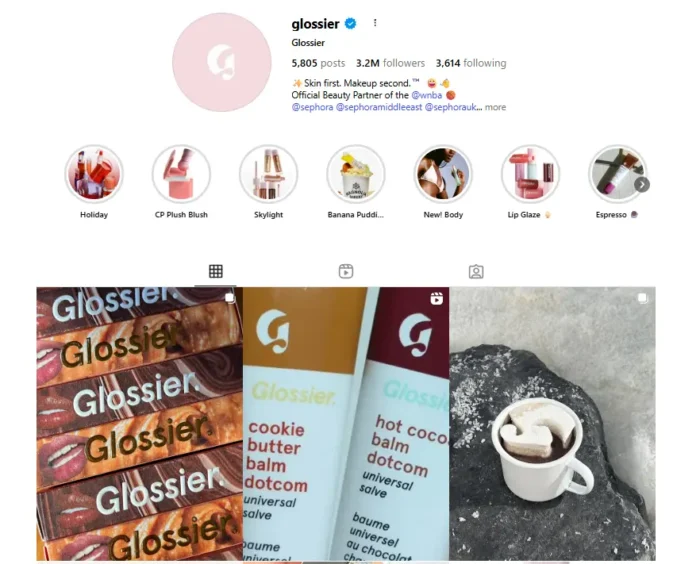
(Image Source)
The payoff can be tremendous. After all, many of Instagram’s 2 billion users actually want to connect with businesses. More than 60 percent of those on Instagram use the platform to follow or research brands and products.
This makes Instagram a top channel for building brand awareness and showing off your products. It’s a platform for building real relationships with your audience.
You just need to know how to use it the right way.
Instagram is now as much a discovery engine as it is a visual app.
Its audience spans every major demographic. Nearly 30 percent of users are 18 to 24, almost 32 percent are between 25 and 34, and engagement among users over 35 continues to grow.
In other words, your customers are already scrolling here.
What makes Instagram especially valuable is the intent behind that activity. Ninety percent of users follow at least one business on the platform.
And many search for products and recommendations directly in-app. That mix of scale and buyer intent makes it one of the best social platforms for brand awareness and conversions alike.
But there’s a bigger reason marketers should care: Search is changing.
AI-powered search models like Google’s AI Overviews and ChatGPT are increasingly pulling content from social platforms like Instagram to understand what’s relevant and credible. That means your brand’s Instagram presence can also strengthen your broader SEO and “search everywhere” strategy.
Even if you’re not ready to run full campaigns, Instagram gives you real-time feedback on what resonates. Watch how your audience engages, and use those insights to shape smarter content across every channel.
Instagram gives marketers a full toolbox, and knowing which tool to use can make all the difference.
Used together, these features create a seamless customer journey: discover, engage, convert.
This may all sound great in theory, but how do you actually start marketing your brand on Instagram? We’ve got you covered.
Before you post anything, get crystal clear on who you want to reach with your Instagram marketing strategy (and why you’re on the platform in the first place). A more focused audience makes everything else easier, from your content strategy and captions to your hashtags and ad targeting.
Start by defining your ideal customer: age, interests, behaviors, and what kind of content grabs their attention. Then look at where your brand overlaps with that.
For example, Nike Running focuses on athletes chasing progress.
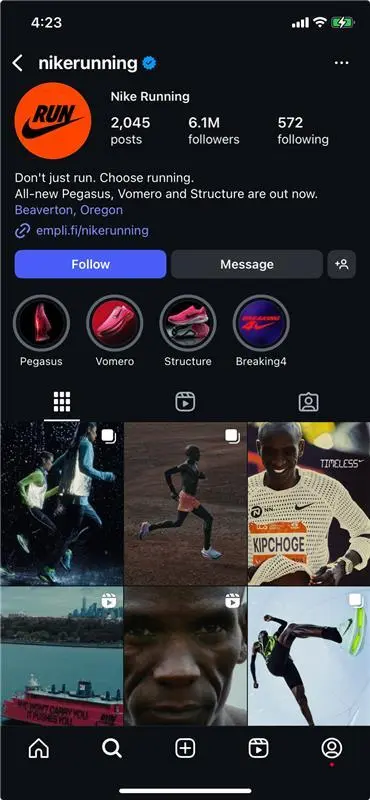
Glossier, on the other hand, speaks directly to beauty fans who love minimal, real-life aesthetics.
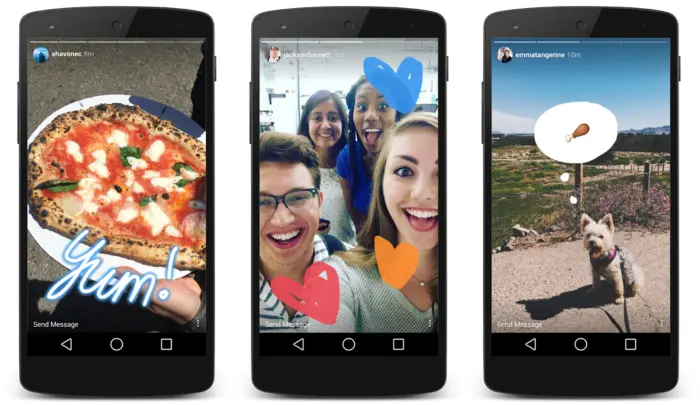
Both Nike and Glossier know exactly who they’re talking to, and it shows in everything they post.
When you understand your audience, you create relevance. And that’s the foundation of every successful Instagram marketing strategy.
Your Instagram profile is your brand’s first impression.
A complete, well-structured profile is a little like a digital business card. It helps followers (and Instagram’s algorithm) understand who you are and why you’re worth following.
Start by switching to a Business or Creator account. It unlocks analytics, contact buttons, and access to Meta’s ad tools. You’re going to need all that if you want to grow strategically.
Then, fill out every available field. Add your profile photo (ideally a recognizable logo or product image), and write a bio that clearly communicates what your brand offers and who it’s for. Short, specific, and benefit-driven wins every time.
You’ll also want to make sure to include:

Don’t skip the category tag under your name, either. It instantly tells visitors what industry you’re in. And if you have multiple offerings, use Story Highlights to organize them into quick-reference guides for new followers.
A complete profile signals professionalism, boosting the odds your content reaches the right audience.
You might associate keyword research mostly with Google, but it’s the foundation of visibility for Instagram marketing, too.
While the platform is built on visuals, discovery still happens through words—in captions, hashtags, and even alt text. That’s how Instagram decides what content to show in search and suggested feeds.
Start simple: Type topics related to your brand into the Instagram search bar.
The auto-suggestions you see? Those are real queries your audience is making right now. Take note of recurring terms and relevant hashtags with active engagement.
Getting a sense for the language your audience uses and weaving it naturally into your posts is how you win. You’ll show up in more searches and connect with people looking for what you offer.
What you post (particularly how it looks) and how often you show up matter just as much as what you say.
On Instagram, your visual identity is your brand voice. Keep the colors you use, the tone of your images, and your captions consistent. Your feed is basically a digital storefront. Every post should look like it belongs there.
Color psychology still plays a major role. Specific colors trigger an emotional reaction in the viewer. When selecting a color palette for your Instagram posts, choose hues that embody your brand’s identity and message.
Drybar, for example, uses a consistent yellow-accent theme across posts, reinforcing brand identity with visual consistency.

Next, experiment with formats.
Standard image posts build brand identity, while Reels boost reach. Stories help you stay top of mind with daily updates, and carousels are great for educational or step-by-step content.
Your goal isn’t necessarily to use every format. It’s more important to focus on the ones that fit your brand’s style and message.
Then there’s timing. Consistency often beats volume. A predictable cadence (say, three to five posts per week) trains both the algorithm and your audience to expect you.
Finally, use hashtags and keywords strategically. Three to five specific, niche hashtags usually outperform generic ones.
The same goes for captions. Natural language that your audience would search for is the way to go. Don’t get too wrapped up in buzzwords.
Remember: Every post reinforces who you are and why you matter to your audience.
Everyone wants to be heard, and your Instagram followers are no different. So, ensure they know you hear and appreciate them by liking their posts and replying to their comments.
Every comment, message, and tag is an opportunity to build trust. And trust fuels growth on Instagram.
Start by responding to comments and DMs quickly. It shows your audience there’s a real person behind the brand. You can also use interactive features like polls, Q&As, and emoji sliders in Stories to invite two-way conversations.

(Image Source)
Don’t stop there.
Reply to comments on your Reels, reshare user-generated content (UGC), and tag followers or partners when it fits naturally.
Brands like Supergoop and Alo Yoga do this well. They answer questions in comments, repost community photos, and encourage followers to tag friends who’d love the product.

(Image Source)
Today, engagement is as much about connection as it is visibility. The more you show up for your audience, the more likely they are to engage and keep you in their feed.
Instagram has some pretty comprehensive analytics that lets you gain both a bird’s-eye view of your performance and a granular view.
Start with Instagram Insights, available for all Business and Creator accounts. You’ll see metrics like reach, impressions, profile visits, and website clicks. These tell you how far your content travels and how effectively your Instagram marketing efforts drive action.
For deeper analysis, tools like Sprout Social, Later, or Hootsuite give you expanded reporting and trend tracking over time.
Don’t just collect data for the sake of collecting it. Put it to good use.
If a certain post drives unusually high engagement, study the caption, image style, or timing. Apply those insights to your next batch of content.
Tracking consistently turns your strategy from guesswork into a growth engine.
With billions of active users, Instagram is a major platform for businesses to market their products and services. However, it can be challenging to stand out from the crowd with so many brands vying for attention.
If you need help getting started, here are our top tips for marketing on Instagram.
Even if you’re not currently using Instagram marketing as a strategy, your competitors most likely are.
Start by identifying three to five brands in your niche with active accounts and solid engagement.
Look at what and how often they’re posting and which formats (Reels, carousels, Stories) get the most traction. Notice the tone of their captions, how they respond to comments, and what hashtags they consistently use.
Tools like Sprout Social, Later, or even Instagram’s built-in dashboard can help you track competitor activity and spot trends over time.
What if you could sell more products by posting product teasers on Instagram?
Well, you can.
Instagram is a great place to advertise your products. And if you play your cards right, you won’t annoy or scare users off with advertisements.
The trick is subtlety.
If you’re too pushy, followers will drop like flies. However, product teaser posts are a simple way to spark curiosity without looking like you’re trying too hard.
This works in almost any industry. For example, Starbucks teases its audience by promoting seasonal drinks with sharp imagery without trying to force people to buy them.
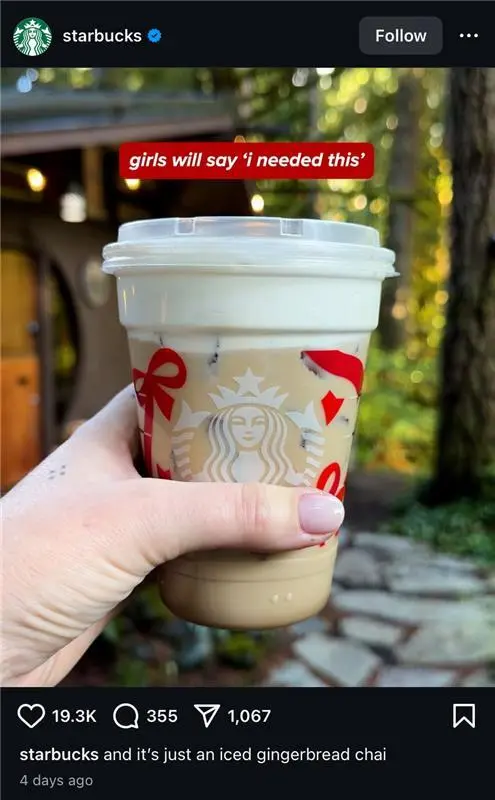
When you tease products people are interested in and don’t push them into buying anything, they’ll be more likely to pull the trigger and buy something.
If not, they might at least engage with your post by liking it, commenting on it, or sharing it with a friend.
A good product teaser shows just enough to make people want more. Use strong visuals or behind-the-scenes clips to highlight what makes your product unique without spelling everything out.
So, don’t be afraid to show off the goods by posting product photos. Just do it gently.
Instagram has quietly become a search engine of its own. Besides scrolling, people search for content, products, and creators using keywords, hashtags, and topics.
That’s where Instagram SEO comes in.
Start by weaving the keywords you found earlier into your captions, alt text, and on-screen text in Reels. Instagram now indexes these areas, which means using natural, descriptive language helps your content show up in relevant searches.
Your username, display name, and bio also play a role. Make sure they clearly reflect your brand and niche. For example, “@JessiesVeganBakery” will always outrank “@JVBakes” for a user searching “vegan bakery.”
Avoid keyword stuffing, but do post with intent. If your audience can search it, say it.
Instagram ads give brands the reach and precision targeting to get in front of exactly the right audience, even if they don’t follow you yet.
Using Ads Manager, you can run campaigns across feed posts, Reels, and Stories, each tailored to different goals like awareness, traffic, or conversions. Reel ads in particular perform well right now, thanks to high engagement and seamless integration into organic content.

You can start small by boosting your top-performing posts to test which visuals and messages resonate most.
Once you see what works, scale those efforts with targeted campaigns using custom or lookalike audiences.
Focus on clean visuals, short captions, and strong calls to action that feel natural in the feed.
And don’t forget your analytics. Performance data from your ads is a goldmine for refining your content and organic strategy.
Short-form video is how audiences consume content today.
Reels help you get discovered. They’re Instagram’s most visible format, with strong algorithmic push and viral potential. Use them in your Instagram marketing strategy to educate, entertain, or inspire. Quick how-tos, behind-the-scenes clips, or shareable tips work especially well.
Stories keep your audience close. They disappear fast, which makes them perfect for time-sensitive content like product launches, polls, or limited-time offers.

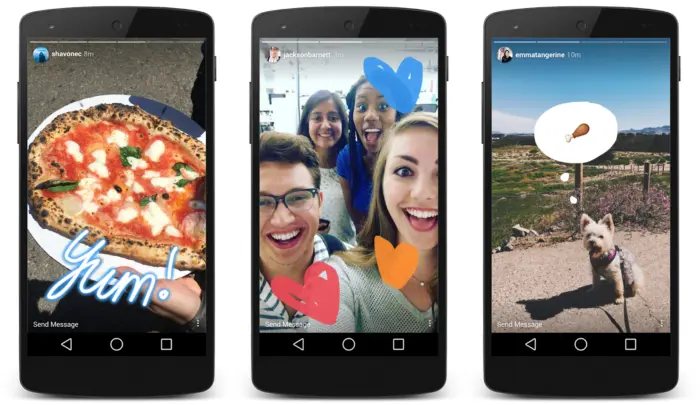
The key to success is consistency and repurposing. A single short video can live as a Reel, a Story, a YouTube Short, and even a LinkedIn post.
Keep videos under 30 seconds, add captions for sound-off viewing, and use on-screen text or stickers to guide attention.
The fastest way to reach potential customers on Instagram is through influencers who already have a large following.
Many people will buy services or products based on what they see in their feeds from the influential people they follow. They trust them.
Start small with your influencer marketing efforts.
You don’t need a celebrity or a million followers to make an impact. Nano- or micro-influencers (creators with smaller but more engaged audiences), for example, can be effective because their recommendations feel personal and real.
For instance, La Croix runs campaigns with micro-influencers who post genuine lifestyle content using their product. These smaller creators drive engaged, niche audiences.
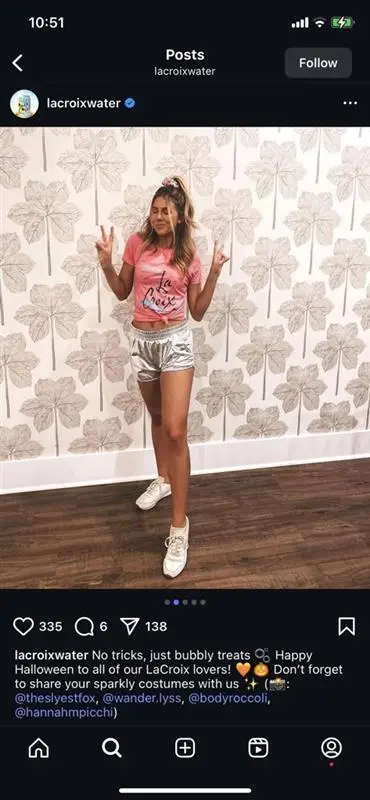
The first step is identifying a few influencers with an audience relevant to your product or service. Look for creators who genuinely align with your brand values and audience.
Study how they engage. Are followers commenting, saving, and sharing? That’s the kind of credibility you want to borrow.
Once you’ve found a match, build a relationship, not a one-off post. Offer creative freedom so influencers can present your product in their own voice. That authenticity performs better than scripted ads.
If you want instant engagement, interactive hashtags are a great way to get it.
Customers can then use the tag to post user-generated content. This allows users to search through all posts relating to your brand.
It also lets you easily search through images you might want to consider reposting on your page.
Creating a hashtag that your company (and other users) can search for is essentially free advertising.
Whenever someone posts a photo using the tag, they expose your company to their followers.
Campaigns like #ShotOniPhone (Apple), which has netted more than 31 million posts, show how branded hashtags can extend far beyond a single promotion.
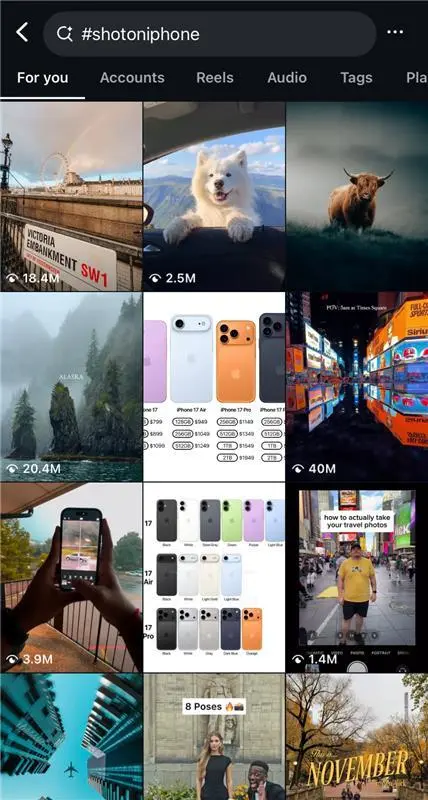
They create recognition and give fans a sense of belonging.
Posting at the right time on Instagram matters. However, over-posting is a surefire way to turn off your existing followers.
If all they see is your brand on their news feed, they will probably unfollow you as fast as possible.
However, you want to post consistently to stay in their news feed regularly. One of the best ways to do this is to only post during peak days and hours when your followers are online.
Recent studies from Later and Sprout Social all point to a similar pattern: Engagement peaks mid-morning to early afternoon, Tuesday through Thursday.
Specifically, Later’s 2025 data shows strong performance between 7–9 a.m. and 11 a.m.–1 p.m., while Sprout Social finds Tuesdays to Thursdays, 11 a.m.–6 p.m. to be the sweet spot.
That said, those are benchmarks, not rules. Use Instagram Insights to see when your followers are most active and schedule posts accordingly.
Aim for three to five posts per week, focusing on quality and rhythm. If you’ve got more to share, batch content into carousels or Stories instead of pushing out multiple posts in a row.
Consistency beats frequency every time. Post when it matters, not just because you can.
People trust people more than brands. That’s why user-generated content is one of the most powerful tools in Instagram marketing.
When customers post real photos or videos of your product, they’re giving you social proof money can’t buy. Reposting that content on your feed or Stories builds community and credibility (and helps fill your content calendar).
To encourage UGC, ask followers to share how they use your product with a branded hashtag or tag your account directly. Feature their posts regularly and give credit in captions or Stories. That recognition goes a long way.
Brands like GoPro built entire communities on UGC, turning their customers into ambassadors.
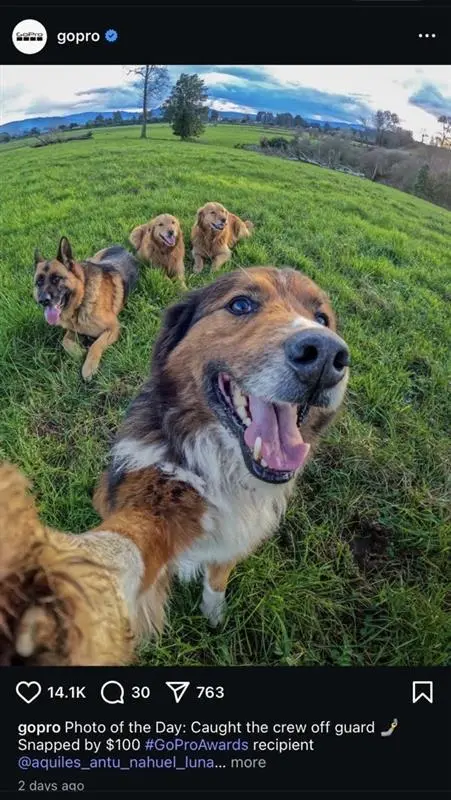
Even smaller brands can replicate GoPro’s approach. All it takes is a clear ask and consistent engagement.
A great photo or Reel grabs attention, but your caption keeps it.
Captions are where your brand voice comes through. They add context, personality, and a reason for people to engage. The best captions feel natural, not scripted.
Write like you’re talking to a friend, not broadcasting to a crowd.
Start with a strong first line. It’s what shows before the “See more” cutoff. Use it to spark emotion or action. Then add value: Tell a quick story or ask a question that invites responses.
Short captions (under 125 characters) tend to perform better for quick-scrolling users, but don’t be afraid of longer ones when you’re telling a meaningful story. Just keep the tone consistent and conversational.
End with a clear next step—a question, call-to-action, or tag—to turn engagement into connection.
On Instagram, your visuals stop the scroll, but your captions build the relationship.
Instagram marketing has evolved into a full shopping experience, where users can tap a tag, view pricing and details, and buy directly from your post or via your website.
That’s frictionless marketing.
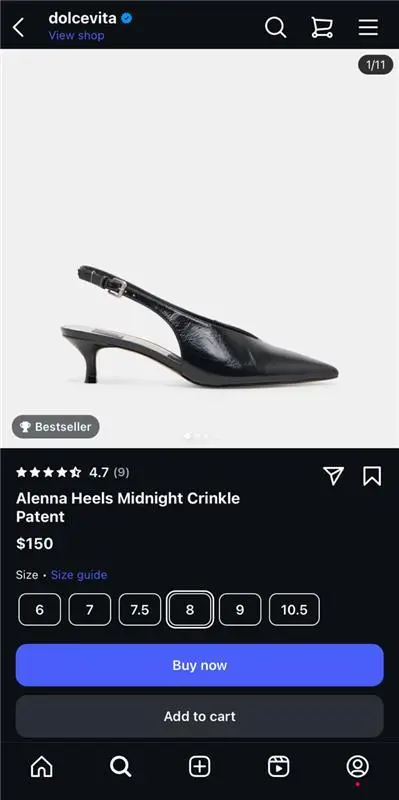
Product tags help your content reach new customers through Instagram’s Shop tab, search, and recommendations, and they also make it easier to track conversions from your posts.
You can tag products in photos, carousels, Reels, and even Stories, linking them to your catalog in Commerce Manager. When paired with influencer or creator posts, product tags create a powerful, connected path from discovery to purchase.
Tagging products turns your organic content into a storefront.
Instagram’s algorithm decides what content gets seen, and it’s smarter than ever.
At its core, the algorithm rewards relevance and interaction. It looks at how users behave—what they like, comment on, save, and share—then prioritizes similar content in their feed, Stories, and Reels tabs.
The biggest ranking signals are:
To work with the algorithm, focus on genuine engagement over volume. Encourage conversation, use relevant hashtags and keywords, and post when your audience is most active.
Instagram never stops evolving.
The biggest changes on the platform revolve around AI and personalization.
Instagram is testing AI content recommendations that surface posts based on visual themes, tone, and engagement signals, not just hashtags. That means smart captioning, keyword use, and audience insights are more important than ever.
You’ll also see new tools for creators and brands, like AI-generated captions and image editing, expanded product tagging for Reels, and enhanced analytics dashboards that show cross-platform performance.
The platform’s Creator marketplace has also expanded, making influencer partnerships easier to manage directly within Instagram. That’s a huge win for brands running multiple campaigns.
The key is to experiment early. Every new feature gives you a short-term visibility boost while competitors lag behind. Keep an eye on the Meta for Business blog or @creators account. Both regularly preview what’s coming next.
Instagram marketing is the use of the platform’s tools, features, and content formats to build awareness, connect with customers, and drive sales. It includes everything from organic content (photos, Reels, and Stories) to paid campaigns, influencer partnerships, and user-generated content.
Whether you’re a global brand or a local small business, Instagram gives you space to grow your audience and drive real results. Here’s where to start:
Boost what’s working: Promote high-performing posts to reach more of your target audience.
Switch to a Business or Creator account: This unlocks analytics, ads, and call-to-action buttons.
Optimize your profile: Include a clear bio, branded visuals, and a link to your site or store.
Start posting consistently: Mix images, Reels, and Stories to see what connects best.
Engage your community: Respond to comments, run polls, and encourage user-generated content.
Instagram marketing can be incredibly effective when done correctly. Instagram remains one of the highest-performing social platforms for engagement and return on investment (ROI). According to Sprout Social’s 2025 report, 29 percent of consumers make purchases on Instagram, and Instagram came in second at 22 percent of marketers reporting it as the highest-ROI social channel.
While wading into the world of social media marketing may seem overwhelming, employing these Instagram marketing tips makes your descent simple.
As you grow your following and interact with your target audience, be sure to keep an eye on your metrics. Look at what’s available from the app itself and those from external platforms like Google Analytics.
From there, double down on what works and adjust quickly when things change, because they always do.
If you need help scaling, consider partnering with Instagram marketing agencies that specialize in strategy, content, and growth.
Continue reading...
Instagram remains one of the most powerful platforms for growing a brand online.
With more than 2 billion active users, Instagram marketing has long been a must if you’re in fashion, beauty, fitness, food, travel, or ecommerce. But it’s not just for visual-first industries anymore. Service businesses and B2B brands are winning here, too.
The catch? You can’t just post and hope for the best. To succeed on Instagram, you need to post the right content to stay relevant to current followers while bringing in new ones.
To grow, you need a smart content strategy and an understanding of how the algorithm works.
This guide will walk you through proven Instagram marketing tips to help you attract followers and drive engagement.
Key Takeaways
- Instagram marketing works best when it’s intentional. Know your audience, post with purpose, and build content that connects rather than just fills a feed.
- Consistency beats frequency. Three to five quality posts a week, backed by Reels and Stories, is often enough to stay visible and relevant.
- Short-form video drives discovery. Reels and Stories remain the fastest way to reach new audiences and spark engagement.
- Engagement fuels the algorithm. Comments, saves, and shares can carry more weight than likes, so encourage interaction and conversation.
- Authenticity wins. From influencer partnerships to user-generated content, real voices and experiences build more trust than polished ads.
What Is Instagram Marketing?
Instagram marketing uses the platform’s creative tools and community reach to help brands build genuine connections and grow their business. At its best, it blends storytelling with strategy, with visuals to pull people in and a message that keeps them interested.
That 1-2 punch should be present in everything from organic posts and Stories to paid ads, influencer partnerships, product tagging, and more.

(Image Source)
The payoff can be tremendous. After all, many of Instagram’s 2 billion users actually want to connect with businesses. More than 60 percent of those on Instagram use the platform to follow or research brands and products.
This makes Instagram a top channel for building brand awareness and showing off your products. It’s a platform for building real relationships with your audience.
You just need to know how to use it the right way.
Why Should Marketers Care About Instagram?
Instagram is now as much a discovery engine as it is a visual app.
Its audience spans every major demographic. Nearly 30 percent of users are 18 to 24, almost 32 percent are between 25 and 34, and engagement among users over 35 continues to grow.
In other words, your customers are already scrolling here.
What makes Instagram especially valuable is the intent behind that activity. Ninety percent of users follow at least one business on the platform.
And many search for products and recommendations directly in-app. That mix of scale and buyer intent makes it one of the best social platforms for brand awareness and conversions alike.
But there’s a bigger reason marketers should care: Search is changing.
AI-powered search models like Google’s AI Overviews and ChatGPT are increasingly pulling content from social platforms like Instagram to understand what’s relevant and credible. That means your brand’s Instagram presence can also strengthen your broader SEO and “search everywhere” strategy.
Even if you’re not ready to run full campaigns, Instagram gives you real-time feedback on what resonates. Watch how your audience engages, and use those insights to shape smarter content across every channel.
Unique Instagram Features for Marketing
Instagram gives marketers a full toolbox, and knowing which tool to use can make all the difference.
- Posts are your foundation. They’re where your brand identity lives. Think of them as the grid that tells your story at a glance. Static images, carousels, and graphics still perform well when they’re cohesive and recognizable. Think of your feed as your brand’s first impression.
- Stories add the real-time connection. They disappear after 24 hours (unless added as a highlight) but consistently drive some of the highest engagement on the platform. Brands use them for behind-the-scenes content, polls, quick updates, or product drops. These types of content feel personal and urgent.
- Reels are Instagram’s growth engine. Short-form video gets prioritized in the algorithm and can extend your reach far beyond followers. Brands like Gymshark and Duolingo use Reels to blend education, entertainment, and personality into discoverable content that quickly builds awareness.
- Livestreams are about interaction. They let you talk directly to your audience, host Q&As, or spotlight a new launch. The immediacy builds trust in a way that pre-edited content can’t.
- Instagram Shop turns discovery into purchase. With product tags, collections, and integrated checkout, followers can go from seeing your post to buying in seconds.
Used together, these features create a seamless customer journey: discover, engage, convert.
How to Get Your Brand Started on Instagram
This may all sound great in theory, but how do you actually start marketing your brand on Instagram? We’ve got you covered.
Zero In on Your Target Audience on Instagram
Before you post anything, get crystal clear on who you want to reach with your Instagram marketing strategy (and why you’re on the platform in the first place). A more focused audience makes everything else easier, from your content strategy and captions to your hashtags and ad targeting.
Start by defining your ideal customer: age, interests, behaviors, and what kind of content grabs their attention. Then look at where your brand overlaps with that.
For example, Nike Running focuses on athletes chasing progress.

Glossier, on the other hand, speaks directly to beauty fans who love minimal, real-life aesthetics.

Both Nike and Glossier know exactly who they’re talking to, and it shows in everything they post.
When you understand your audience, you create relevance. And that’s the foundation of every successful Instagram marketing strategy.
Optimize Your Instagram Profile
Your Instagram profile is your brand’s first impression.
A complete, well-structured profile is a little like a digital business card. It helps followers (and Instagram’s algorithm) understand who you are and why you’re worth following.
Start by switching to a Business or Creator account. It unlocks analytics, contact buttons, and access to Meta’s ad tools. You’re going to need all that if you want to grow strategically.
Then, fill out every available field. Add your profile photo (ideally a recognizable logo or product image), and write a bio that clearly communicates what your brand offers and who it’s for. Short, specific, and benefit-driven wins every time.
You’ll also want to make sure to include:
- Contact information: Include your physical address, email address, and phone number so followers can contact you directly. When you include this contact information, Instagram automatically builds related buttons (Call, Get Directions, Email).
- Category or categories: These groupings appear as circular topics under your name and are a simple way to showcase what your brand is about. Check out our page to see how we do it.
- Call-to-action buttons: You can tailor your buttons to your business offerings (like Book Now or Order Food) to allow visitors to take specific actions, like making an appointment or booking a reservation. To incorporate these buttons into your profile, select Edit profile and tap Action buttons.

Don’t skip the category tag under your name, either. It instantly tells visitors what industry you’re in. And if you have multiple offerings, use Story Highlights to organize them into quick-reference guides for new followers.
A complete profile signals professionalism, boosting the odds your content reaches the right audience.
Do Some Starter Keyword Research
You might associate keyword research mostly with Google, but it’s the foundation of visibility for Instagram marketing, too.
While the platform is built on visuals, discovery still happens through words—in captions, hashtags, and even alt text. That’s how Instagram decides what content to show in search and suggested feeds.
Start simple: Type topics related to your brand into the Instagram search bar.
The auto-suggestions you see? Those are real queries your audience is making right now. Take note of recurring terms and relevant hashtags with active engagement.
Getting a sense for the language your audience uses and weaving it naturally into your posts is how you win. You’ll show up in more searches and connect with people looking for what you offer.
Start Posting High-Quality Content
What you post (particularly how it looks) and how often you show up matter just as much as what you say.
On Instagram, your visual identity is your brand voice. Keep the colors you use, the tone of your images, and your captions consistent. Your feed is basically a digital storefront. Every post should look like it belongs there.
Color psychology still plays a major role. Specific colors trigger an emotional reaction in the viewer. When selecting a color palette for your Instagram posts, choose hues that embody your brand’s identity and message.
Drybar, for example, uses a consistent yellow-accent theme across posts, reinforcing brand identity with visual consistency.

Next, experiment with formats.
Standard image posts build brand identity, while Reels boost reach. Stories help you stay top of mind with daily updates, and carousels are great for educational or step-by-step content.
Your goal isn’t necessarily to use every format. It’s more important to focus on the ones that fit your brand’s style and message.
Then there’s timing. Consistency often beats volume. A predictable cadence (say, three to five posts per week) trains both the algorithm and your audience to expect you.
Finally, use hashtags and keywords strategically. Three to five specific, niche hashtags usually outperform generic ones.
The same goes for captions. Natural language that your audience would search for is the way to go. Don’t get too wrapped up in buzzwords.
Remember: Every post reinforces who you are and why you matter to your audience.
Engage With Followers
Everyone wants to be heard, and your Instagram followers are no different. So, ensure they know you hear and appreciate them by liking their posts and replying to their comments.
Every comment, message, and tag is an opportunity to build trust. And trust fuels growth on Instagram.
Start by responding to comments and DMs quickly. It shows your audience there’s a real person behind the brand. You can also use interactive features like polls, Q&As, and emoji sliders in Stories to invite two-way conversations.

(Image Source)
Don’t stop there.
Reply to comments on your Reels, reshare user-generated content (UGC), and tag followers or partners when it fits naturally.
Brands like Supergoop and Alo Yoga do this well. They answer questions in comments, repost community photos, and encourage followers to tag friends who’d love the product.

(Image Source)
Today, engagement is as much about connection as it is visibility. The more you show up for your audience, the more likely they are to engage and keep you in their feed.
Track Your Analytics
Instagram has some pretty comprehensive analytics that lets you gain both a bird’s-eye view of your performance and a granular view.
Start with Instagram Insights, available for all Business and Creator accounts. You’ll see metrics like reach, impressions, profile visits, and website clicks. These tell you how far your content travels and how effectively your Instagram marketing efforts drive action.
- Reach and Impressions: Show how many unique users saw your content and how often. A spike can signal that a post hit the right tone or format.
- Engagement: Likes, comments, shares, saves, and Reels interactions show what truly resonates. Saves, in particular, are a sign of high-value content.
- Conversions: Use UTM links or Meta Business Suite to track traffic, leads, and sales coming from your Instagram content or ads.
For deeper analysis, tools like Sprout Social, Later, or Hootsuite give you expanded reporting and trend tracking over time.
Don’t just collect data for the sake of collecting it. Put it to good use.
If a certain post drives unusually high engagement, study the caption, image style, or timing. Apply those insights to your next batch of content.
Tracking consistently turns your strategy from guesswork into a growth engine.
Top Tips for Instagram Marketing
With billions of active users, Instagram is a major platform for businesses to market their products and services. However, it can be challenging to stand out from the crowd with so many brands vying for attention.
If you need help getting started, here are our top tips for marketing on Instagram.
1. Run Competitive Research
Even if you’re not currently using Instagram marketing as a strategy, your competitors most likely are.
Start by identifying three to five brands in your niche with active accounts and solid engagement.
Look at what and how often they’re posting and which formats (Reels, carousels, Stories) get the most traction. Notice the tone of their captions, how they respond to comments, and what hashtags they consistently use.
Tools like Sprout Social, Later, or even Instagram’s built-in dashboard can help you track competitor activity and spot trends over time.
2. Post Product Teasers That Will (Gently) Urge People to Buy
What if you could sell more products by posting product teasers on Instagram?
Well, you can.
Instagram is a great place to advertise your products. And if you play your cards right, you won’t annoy or scare users off with advertisements.
The trick is subtlety.
If you’re too pushy, followers will drop like flies. However, product teaser posts are a simple way to spark curiosity without looking like you’re trying too hard.
This works in almost any industry. For example, Starbucks teases its audience by promoting seasonal drinks with sharp imagery without trying to force people to buy them.

When you tease products people are interested in and don’t push them into buying anything, they’ll be more likely to pull the trigger and buy something.
If not, they might at least engage with your post by liking it, commenting on it, or sharing it with a friend.
A good product teaser shows just enough to make people want more. Use strong visuals or behind-the-scenes clips to highlight what makes your product unique without spelling everything out.
So, don’t be afraid to show off the goods by posting product photos. Just do it gently.
3. Practice Instagram SEO to Optimize Your Posts
Instagram has quietly become a search engine of its own. Besides scrolling, people search for content, products, and creators using keywords, hashtags, and topics.
That’s where Instagram SEO comes in.
Start by weaving the keywords you found earlier into your captions, alt text, and on-screen text in Reels. Instagram now indexes these areas, which means using natural, descriptive language helps your content show up in relevant searches.
Your username, display name, and bio also play a role. Make sure they clearly reflect your brand and niche. For example, “@JessiesVeganBakery” will always outrank “@JVBakes” for a user searching “vegan bakery.”
Avoid keyword stuffing, but do post with intent. If your audience can search it, say it.
4. Create Sponsored Ads
Instagram ads give brands the reach and precision targeting to get in front of exactly the right audience, even if they don’t follow you yet.
Using Ads Manager, you can run campaigns across feed posts, Reels, and Stories, each tailored to different goals like awareness, traffic, or conversions. Reel ads in particular perform well right now, thanks to high engagement and seamless integration into organic content.

You can start small by boosting your top-performing posts to test which visuals and messages resonate most.
Once you see what works, scale those efforts with targeted campaigns using custom or lookalike audiences.
Focus on clean visuals, short captions, and strong calls to action that feel natural in the feed.
And don’t forget your analytics. Performance data from your ads is a goldmine for refining your content and organic strategy.
5. Use Instagram Reels and Stories
Short-form video is how audiences consume content today.
Reels help you get discovered. They’re Instagram’s most visible format, with strong algorithmic push and viral potential. Use them in your Instagram marketing strategy to educate, entertain, or inspire. Quick how-tos, behind-the-scenes clips, or shareable tips work especially well.
Stories keep your audience close. They disappear fast, which makes them perfect for time-sensitive content like product launches, polls, or limited-time offers.


The key to success is consistency and repurposing. A single short video can live as a Reel, a Story, a YouTube Short, and even a LinkedIn post.
Keep videos under 30 seconds, add captions for sound-off viewing, and use on-screen text or stickers to guide attention.
6. Partner With Influencers for a Wider Reach
The fastest way to reach potential customers on Instagram is through influencers who already have a large following.
Many people will buy services or products based on what they see in their feeds from the influential people they follow. They trust them.
Start small with your influencer marketing efforts.
You don’t need a celebrity or a million followers to make an impact. Nano- or micro-influencers (creators with smaller but more engaged audiences), for example, can be effective because their recommendations feel personal and real.
For instance, La Croix runs campaigns with micro-influencers who post genuine lifestyle content using their product. These smaller creators drive engaged, niche audiences.

The first step is identifying a few influencers with an audience relevant to your product or service. Look for creators who genuinely align with your brand values and audience.
Study how they engage. Are followers commenting, saving, and sharing? That’s the kind of credibility you want to borrow.
Once you’ve found a match, build a relationship, not a one-off post. Offer creative freedom so influencers can present your product in their own voice. That authenticity performs better than scripted ads.
7. Come Up With an Interactive Branded Hashtag
If you want instant engagement, interactive hashtags are a great way to get it.
Customers can then use the tag to post user-generated content. This allows users to search through all posts relating to your brand.
It also lets you easily search through images you might want to consider reposting on your page.
Creating a hashtag that your company (and other users) can search for is essentially free advertising.
Whenever someone posts a photo using the tag, they expose your company to their followers.
Campaigns like #ShotOniPhone (Apple), which has netted more than 31 million posts, show how branded hashtags can extend far beyond a single promotion.

They create recognition and give fans a sense of belonging.
8. Post at The Right Times (and Don’t Over-Post)
Posting at the right time on Instagram matters. However, over-posting is a surefire way to turn off your existing followers.
If all they see is your brand on their news feed, they will probably unfollow you as fast as possible.
However, you want to post consistently to stay in their news feed regularly. One of the best ways to do this is to only post during peak days and hours when your followers are online.
Recent studies from Later and Sprout Social all point to a similar pattern: Engagement peaks mid-morning to early afternoon, Tuesday through Thursday.
Specifically, Later’s 2025 data shows strong performance between 7–9 a.m. and 11 a.m.–1 p.m., while Sprout Social finds Tuesdays to Thursdays, 11 a.m.–6 p.m. to be the sweet spot.
That said, those are benchmarks, not rules. Use Instagram Insights to see when your followers are most active and schedule posts accordingly.
Aim for three to five posts per week, focusing on quality and rhythm. If you’ve got more to share, batch content into carousels or Stories instead of pushing out multiple posts in a row.
Consistency beats frequency every time. Post when it matters, not just because you can.
9. Use User-Generated Content
People trust people more than brands. That’s why user-generated content is one of the most powerful tools in Instagram marketing.
When customers post real photos or videos of your product, they’re giving you social proof money can’t buy. Reposting that content on your feed or Stories builds community and credibility (and helps fill your content calendar).
To encourage UGC, ask followers to share how they use your product with a branded hashtag or tag your account directly. Feature their posts regularly and give credit in captions or Stories. That recognition goes a long way.
Brands like GoPro built entire communities on UGC, turning their customers into ambassadors.

Even smaller brands can replicate GoPro’s approach. All it takes is a clear ask and consistent engagement.
10. Build Strong Captions
A great photo or Reel grabs attention, but your caption keeps it.
Captions are where your brand voice comes through. They add context, personality, and a reason for people to engage. The best captions feel natural, not scripted.
Write like you’re talking to a friend, not broadcasting to a crowd.
Start with a strong first line. It’s what shows before the “See more” cutoff. Use it to spark emotion or action. Then add value: Tell a quick story or ask a question that invites responses.
Short captions (under 125 characters) tend to perform better for quick-scrolling users, but don’t be afraid of longer ones when you’re telling a meaningful story. Just keep the tone consistent and conversational.
End with a clear next step—a question, call-to-action, or tag—to turn engagement into connection.
On Instagram, your visuals stop the scroll, but your captions build the relationship.
11. Got Products In Your Content? Tag Them
Instagram marketing has evolved into a full shopping experience, where users can tap a tag, view pricing and details, and buy directly from your post or via your website.
That’s frictionless marketing.

Product tags help your content reach new customers through Instagram’s Shop tab, search, and recommendations, and they also make it easier to track conversions from your posts.
You can tag products in photos, carousels, Reels, and even Stories, linking them to your catalog in Commerce Manager. When paired with influencer or creator posts, product tags create a powerful, connected path from discovery to purchase.
Tagging products turns your organic content into a storefront.
12. Understand the Instagram Algorithm
Instagram’s algorithm decides what content gets seen, and it’s smarter than ever.
At its core, the algorithm rewards relevance and interaction. It looks at how users behave—what they like, comment on, save, and share—then prioritizes similar content in their feed, Stories, and Reels tabs.
The biggest ranking signals are:
- Engagement quality: Saves, shares, and comments weigh more than likes.
- Consistency: Accounts that post regularly stay visible.
- Relationships: Content from people or brands users interact with most appears first.
- Format variety: Using Reels, Stories, and carousels helps signal an active, valuable account.
To work with the algorithm, focus on genuine engagement over volume. Encourage conversation, use relevant hashtags and keywords, and post when your audience is most active.
13. Keep Track of New Updates and Features
Instagram never stops evolving.
The biggest changes on the platform revolve around AI and personalization.
Instagram is testing AI content recommendations that surface posts based on visual themes, tone, and engagement signals, not just hashtags. That means smart captioning, keyword use, and audience insights are more important than ever.
You’ll also see new tools for creators and brands, like AI-generated captions and image editing, expanded product tagging for Reels, and enhanced analytics dashboards that show cross-platform performance.
The platform’s Creator marketplace has also expanded, making influencer partnerships easier to manage directly within Instagram. That’s a huge win for brands running multiple campaigns.
The key is to experiment early. Every new feature gives you a short-term visibility boost while competitors lag behind. Keep an eye on the Meta for Business blog or @creators account. Both regularly preview what’s coming next.
FAQs
What is Instagram marketing?
Instagram marketing is the use of the platform’s tools, features, and content formats to build awareness, connect with customers, and drive sales. It includes everything from organic content (photos, Reels, and Stories) to paid campaigns, influencer partnerships, and user-generated content.
How do I market on Instagram?
Whether you’re a global brand or a local small business, Instagram gives you space to grow your audience and drive real results. Here’s where to start:
Boost what’s working: Promote high-performing posts to reach more of your target audience.
Switch to a Business or Creator account: This unlocks analytics, ads, and call-to-action buttons.
Optimize your profile: Include a clear bio, branded visuals, and a link to your site or store.
Start posting consistently: Mix images, Reels, and Stories to see what connects best.
Engage your community: Respond to comments, run polls, and encourage user-generated content.
Is Instagram marketing effective?
Instagram marketing can be incredibly effective when done correctly. Instagram remains one of the highest-performing social platforms for engagement and return on investment (ROI). According to Sprout Social’s 2025 report, 29 percent of consumers make purchases on Instagram, and Instagram came in second at 22 percent of marketers reporting it as the highest-ROI social channel.
Conclusion
While wading into the world of social media marketing may seem overwhelming, employing these Instagram marketing tips makes your descent simple.
As you grow your following and interact with your target audience, be sure to keep an eye on your metrics. Look at what’s available from the app itself and those from external platforms like Google Analytics.
From there, double down on what works and adjust quickly when things change, because they always do.
If you need help scaling, consider partnering with Instagram marketing agencies that specialize in strategy, content, and growth.
Continue reading...